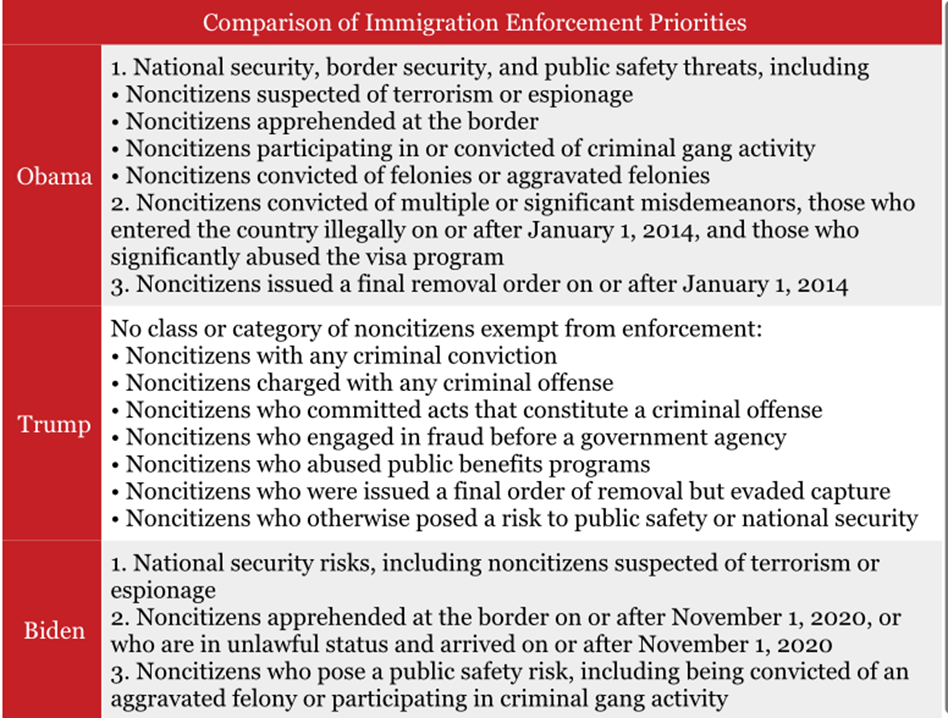Comparison of the Obama, Trump, and Biden Administration Immigration Enforcement Priorities
April 22, 2021
Law Enforcement Immigration Task Force News & Resources
For a PDF version, click here.
10/27/21 update: On September 30, DHS released Guidelines for the Enforcement of Civil Immigration Law, new immigration enforcement priorities that emphasize the use of prosecutorial discretion to seek targeted enforcement. For updated information on these priorities from the Biden administration, please click here.
Introduction
Over the past decade, the Obama, Trump, and Biden administrations have prioritized different categories of persons in carrying out immigration enforcement functions. These varying frameworks, known as immigration enforcement priorities, describe how the federal immigration enforcement apparatus deploys limited resources to arrest and/or remove non-citizens.
To this end, the Obama administration created immigration enforcement priorities to channel limited resources towards individuals it deemed to be high priorities, including threats to national security, threats to public safety, and recent illegal entrants. Departing from this approach, the Trump administration sought to consider all undocumented immigrants high priorities for removal, expanding the categories so broadly as to render the priorities meaningless. To this point, the Biden administration is – at least on an interim basis – returning to an Obama-like framework, in similarly utilizing limited resources to prioritize threats to national security, threats to public safety, and recent illegal entrants. Below are detailed summaries of each administration’s priorities:
Obama administration: focus on threats and recent entrants
Citing the limited resources available for immigration enforcement and the impossibility of deporting 11 million undocumented people, the Obama administration sought to prioritize the use of the agency’s enforcement personnel, detention space, and removal assets. Noting that ICE could only remove an estimated 400,000 undocumented immigrants a year at most, representing less than 4% of the undocumented population in the U.S. during that time, the administration sought to channel limited resources towards more urgent threats.
In a set of 2010 and 2011 memoranda from then-U.S. Immigration and Customs Enforcement (ICE) Director John Morton, the Obama administration created three categories of undocumented immigrants that would be prioritized for arrest and deportation.
The first priority consisted of undocumented immigrants who posed a threat to national security or public safety, including those engaged in or suspected of terrorism or espionage, those convicted of a crime or possessing outstanding criminal warrants, or those who participated in organized criminal gang activity. Within this priority category, ICE would draw distinctions based on the severity of convictions: level 1 offenders were convicted of aggravated felonies, level 2 offenders were convicted of any felony, and level 3 offenders were convicted of a misdemeanor.
The second priority consisted of undocumented immigrants who recently unlawfully entered the United States. The third priority consisted of undocumented immigrants who obstructed immigration controls, including those who re-entered the U.S. unlawfully after removal, didn’t heed a final order of removal, or engaged in visa or identification fraud.
Building upon this framework, then-Department of Homeland Security (DHS) Secretary Jeh Johnson issued new enforcement priorities that applied DHS-wide. These guidelines redefined the prioritization of undocumented immigrants as 1) threats to national security, border security, and public safety; 2) misdemeanants and new immigration violators and; 3) other immigration violators.
While the first priority stayed largely the same in prioritizing undocumented immigrants engaged in or suspected of terrorism or espionage and those who participated in organized criminal gang activity, it no longer included those convicted of a misdemeanor (or a level 3 offender). Rather, it applied only to those convicted with an aggravated felony or felony (level 1 and 2 offenders). This difference is evident through the revised second priority, which targeted undocumented immigrants convicted of three misdemeanor offenses or a “significant” misdemeanor, those who recently unlawfully entered the United States, and those who abused the visa programs. In effect, the priority of misdemeanants was lessened from priority 1 to priority 2, recent unlawful entrance was kept at priority 2, and the priority of those who abused the visa program was increased from priority 3 to priority 2. The third priority, similar to its predecessor, applied to undocumented immigrants who had been issued a final order of removal, but did not prioritize fugitives or those engaged in fraud. Beyond deprioritizing misdemeanor convictions, the Johnson priorities largely kept the same distinctions and structure as the Morton priorities.
Both sets of Obama-era priorities emphasized that “prosecutorial discretion” must be regularly exercised in order to decide the appropriate degree of enforcement against a particular individual. In Morton’s original memorandum, the list of factors to consider when exercising prosecutorial discretion ranged from an individual’s ties and contributions to the community to whether the individual’s spouse is pregnant or nursing. In addition, the Morton guidance included a list of positive factors that should “prompt particular care and consideration” including whether the individual is a veteran or member of the U.S. armed forces, a minor or elderly individual, or a victim of domestic violence, trafficking, or other serious crime. The guidance also included a list of negative factors, including whether the individual poses a clear risk to national security, is a serious felon, or is a known gang member.
Similarly, the Johnson guidance directed DHS personnel to consider extenuating circumstances such as length of time in the United States, military service, family or community ties in the U.S, compelling humanitarian factors, or status as a victim. Both guidelines directed ICE to exercise discretion as early as possible in the case or proceedings, in order to prevent waste of government resources, and clarified that nothing in the released memorandums should be construed to prohibit the apprehension, detention, or removal of any undocumented immigrant in the U.S.
Both sets of Obama administration enforcement priorities focused limited immigration enforcement resources on risks to public safety and recent entrants, as opposed to people posing no danger to the public and/or with longstanding ties. And through the guidance governing prosecutorial discretion, the Obama administration provided for DHS officials to give special consideration to lawful permanent residents (LPRs), juveniles, and immediate family members of U.S. citizens, helping prevent the needless separation of U.S. families and communities.
Trump administration: all undocumented migrants are priorities
The Trump administration abandoned the Obama framework, asserting that all undocumented migrants were deemed priorities for apprehension and removal. On January 25, 2017, the Trump administration issued an Executive Order entitled “Enhancing Public Safety in the Interior of the United States,” which, along with subsequent DHS guidance, effectively “prioritized” all undocumented immigrants for removal at any time. The Trump priorities set out seven broad categories, including new categories for those who engaged in visa fraud or identification misrepresentation. However, in contrast to the Obama administration’s tiered prioritization categories, the Trump administration asserted that each of the categories were of equal weight – serious offenses shared the same priority as minor ones. Effectively, the Trump guidance expanded the understanding of “enforcement priority” “so broadly as to render the term meaningless.”
In effect, the Trump administration indicated that anyone who was deportable or inadmissible was a priority for removal. The Trump guidance not only directed the prioritization for the arrest and deportation of any undocumented immigrant who had been convicted or even charged with a criminal offense – it also prioritized those merely deemed to “have committed acts which constitute a chargeable criminal offense.” In addition, the guidance included a broad, ill-defined catch-all category for those who “in the judgment of an immigration officer, otherwise pose a risk to public safety or national security.” These broad categories could be extended to cover those with minor offenses like speeding, or those who committed immigration offenses, like unlawful entry, even if they never were charged with those offenses.
By equally prioritizing those convicted of crimes, those charged with crimes, and those whose conduct did not lead to charges, but whose conduct could “constitute” a chargeable offense or could be deemed to be a public safety risk, the Trump guidance significantly expanded the universe of prioritized migrants. In addition, unlike the Obama administration guidance, the Trump guidance did not distinguish between seriousness of offenses, prioritizing – at least in theory – minor traffic offenses equally with violent crimes.
Furthermore, the Trump DHS issued a memorandum foreswearing the use of prosecutorial discretion to deprioritize low risk groups or those with longstanding ties to the U.S. The memorandum stated that “prosecutorial discretion shall not be exercised in a manner that exempts or excludes a specified class or category of noncitizens from enforcement of immigration laws.” A stark contrast from the Obama administration orders that discretion be assessed on the basis of length of time in the U.S., social ties and U.S. citizen family members, or military service, the Trump administration severely limited the discretionary authority of immigration-enforcement personnel. Instead, ICE personnel were expected to execute immigration laws against all removable individuals.
These broad enforcement priorities translated to more arrests and deportations of less serious offenders and fewer arrests and deportations of more serious offenders. According to ICE data, the monthly number of level 3 (misdemeanors) offenders detained climbed from 6,000 in March 2015 to 9,500 in April 2019. At the same time, the number of level 1 (felony and aggravated felony) offenders detained decreased from 7,500 to 6,000. Additionally, an estimated 1 in 10 undocumented individuals arrested during FY2017 had neither a criminal conviction or charge. By targeting the entire undocumented population rather than those who posed threats, the Trump prioritization policy faced criticism for wasting resources.
Biden administration: seeks return to prioritizing threats and recent entrants
As a candidate for president in 2020, Joe Biden promised to “[r]estore sensible [immigration] enforcement priorities.” On January 20, 2021 – his first day in office – he issued an executive order revoking former President Trump’s executive order on interior immigration enforcement and directing DHS to conduct a review of the policies and practices concerning immigration enforcement. During the course of that review, he ordered a 100-day pause on deportations, excluding individuals suspected of terrorism or espionage or who entered the U.S. after November 1, 2020; however, that moratorium has been halted by a federal judge in Texas. The remainder of the Biden executive order remains in effect.
The DHS-wide review of immigration enforcement policies and practices is intended to be used to develop recommendations to address immigration enforcement, “including policies for prioritizing the use of enforcement personnel, detention space, and removal assets; policies governing the exercise of prosecutorial discretion; policies governing detention; and policies regarding interaction with state and local law enforcement.” DHS is expected to provide these recommendations no later than April 30, 2021, in order to ensure that the Department’s resources are allocated where they are most needed.
Like the Obama administration, the Biden administration has grounded the need for prioritization in DHS’s limited resources and the impossibility of removing all undocumented immigrants from the U.S. In a January 20 memorandum from acting DHS secretary David Pekoske , the administration directed that DHS’s interim immigration enforcement priorities are undocumented immigrants who pose a threat to 1) national security; 2) border security and; 3) public safety. These guidelines, modified and further built out by a February 18 memorandum from ICE acting director Tae Johnson, represent a break from the Trump administration and a return to the structure of Obama administration prioritization, with some modifications. DHS Secretary Alejandro Mayorkas is expected to issue permanent guidelines in the spring, following the review of DHS policies.
Like the Obama-era guidelines, the Biden interim guidelines first prioritize individuals convicted of or suspected of engaging in terrorism or espionage, and then prioritizes recent unlawful entrants with fewer ties to the U.S. However, while the Biden administration continues to prioritize public safety threats as enforcement priorities, those convicted of aggravated felonies are listed in the third category. This represents somewhat of a departure from the Obama administration priorities, which included them as a higher priority. Notably, the January Biden interim guidelines do not mention lesser criminal convictions – a shift not only from the Trump-era guidelines, but also the Obama prioritization guidelines, which included serious misdemeanors under the third priority.
In the supplemental interim ICE guidance of February 18, the Biden administration expanded the initial January guidance. The February guidance applies to enforcement actions, custody decisions, execution of final orders of removal, financial expenditures and strategic planning within ICE. It continues the January framework focusing on 1) national security; 2) border security and; 3) public safety. However, it expressly includes those convicted of or who have intentionally participated in organized criminal gang activity under the third priority category.
The February interim guidelines, which will be in effect for 90 days, are meant to allow ICE to better utilize its resources, while still prioritizing public safety threats. The February guidelines revised the moratorium in giving ICE officers the authorization to apprehend presumed priority undocumented immigrants without prior approval. However, under the guidelines, preapproval from one of ICE’s 24 Field Office Directors is still required for removal of any undocumented immigrant who is not a national security threat, did not recently cross the border, and has not been convicted of an aggravated-felony or involved in criminal gang activity. The new rules also include additional reporting and oversight requirements, such as requiring ICE field offices to submit weekly reports to the Office of the Director and Office of Policy and Planning detailing enforcement action taken in the prior week.
The Biden guidance largely restores the Obama administration’s recommendations regarding the use of prosecutorial discretion. The guidance instructs ICE officers to consider mitigating factors in making an arrest of an undocumented immigrant, including whether the criminal offense was recent, if the individual has ties to U.S. citizens, and if the individual is suffering from a serious physical or mental illness. Similarly, ICE officers are instructed to consider if the undocumented immigrant has filed an appeal on an order of removal, a motion to reopen removal proceedings, or has pending applications for immigration relief. In these circumstances, it is expected that ICE officers have a compelling reason for removal, as well as approval from the Field Office Director. While the interim enforcement priorities do not exempt any undocumented immigrant from enforcement, it provides clearer instructions to ICE officers in order to maximize the agency’s impact.
These narrower-defined priorities are expected to result in significant declines in immigration arrests and deportations of people without criminal convictions, accompanied by a likely increase of those with criminal convictions. A study of ICE data revealed that 93,000 undocumented immigrants arrested by ICE officers in FY2020 had more than 374,000 criminal convictions or pending charges, but only about 10 to 20 percent of them were aggravated felony convictions, meaning that only a handful would be prioritized under the Biden interim guidelines.
Recommendations
The Biden administration’s interim immigration enforcement guidance represents a needed return to prioritizing threats, channeling limited law enforcement resources in a more effective manner. As the Biden administration prepares to release its final priorities on immigration enforcement, it should continue to prioritize threats to national security, border security and public safety.
To the extent it can, the administration should clarify existing ambiguities in the guidance, providing clarity to help direct DHS officers and agents while making decisions in the field. Specifically, further guidance on what constitutes a national security threat or what conduct constitutes gang activity, would go far in aiding DHS personnel while helping ensure individuals are not wrongfully categorized as a threat where they are not.
Similarly, while the Biden administration issuing interim guidance on the use of prosecutorial discretion is promising, it is uncertain whether DHS officials will adequately apply those factors to its cases. In its final guidance, the Biden administration should enshrine a more formalized process under which DHS officials seek out, including setting out broad categories for which there is a presumption against enforcement – like caregivers, essential workers, or those with pending applications before USCIS. The Biden guidance can also go further in encouraging favorable uses of prosecutorial discretion where there are strong mitigating factors, creating a process to identify cases, such as where a criminal conviction is from the distant past, or where the individual’s family and community ties may merit non-enforcement.
Table Comparison of Administration Priorities




